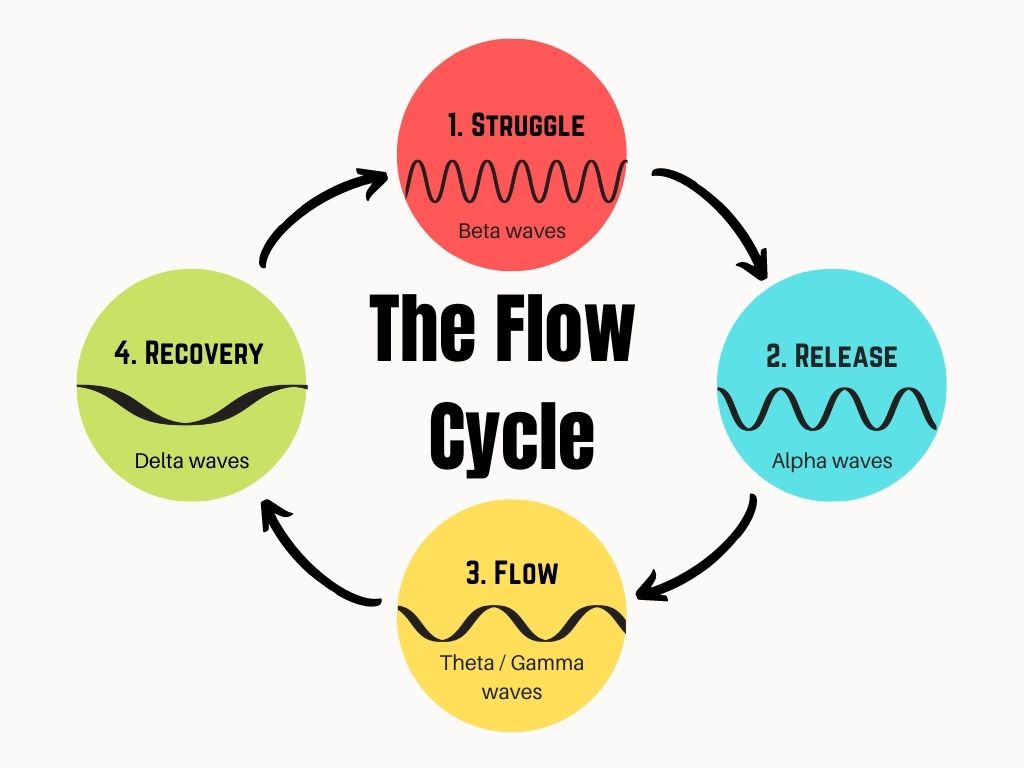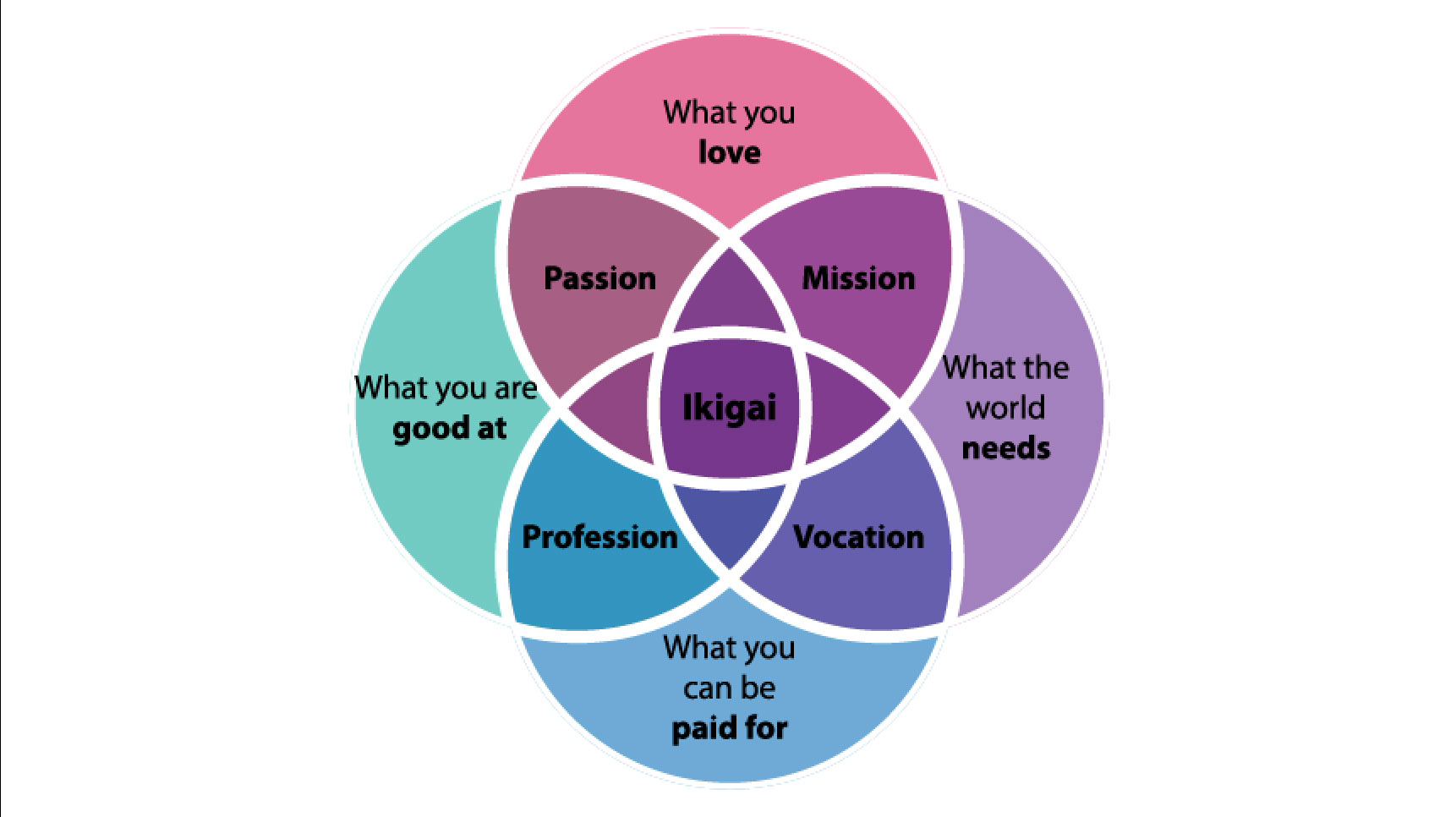Everything you do and think is going to show up in your brain somehow. When you’re frustrated, when you learn a language, move your arm, or fall in love, there will be some neurons, and brain regions will light up.
This is also the case when we enter a flow state. When we start to perform at our best, when we lose our sense of time, when our inner critic goes quiet and our attention consumed, we can look inside the brain to see what’s going on in a less subjective, more physical sense.
In doing so, we might be able to get a greater understanding of the benefits of flow and how we can achieve it. While there is still a lot to learn, we know that different stages of flow in what’s called the Flow Cycle with their own unique signature of brain waves and neurotransmitter activity.
The Flow Cycle:

Flow states that result in feelings of selflessness, timelessness, effortlessness and richness tend to show up in low alpha and high theta brainwave states.
Here’s how to apply the Flow Cycle to get into more flow states in your challenging activities:
1. The Struggle
When we first attempt to learn something or solve a difficult problem, consciousness is fully involved and there is often a feeling of frustration, difficulty, and stress. We’re unlikely to enter flow as our abilities are not where they need to be, rather, we are overwhelmed by how much we need to absorb and process.
At this initial stage adrenaline and cortisol are often present, raising our heart rate and blood pressure, dilating our pupils and preparing the body to deal with a stressful situation. At this point your brain waves are in the BETA range of 12-40 Hz.
“When the brain is aroused and actively engaged in mental activities, it generates beta waves. These beta waves are of relatively low amplitude, and are the fastest of the different brainwaves,” writes American creativity researcher Ned Herrmann.
2. The Release
After struggling for a while it’s necessary to put the problem away, think about something else, take a break and give the mind a chance to reset. Doing so allows the stress hormones from the struggle phase to be flushed out, so to speak.
At this point, our brain waves sink down to ALPHA levels of 8-12 Hz. Ned Herrmann continues, “Alpha brainwaves are slower, and higher in amplitude. … A person who has completed a task and sits down to rest is often in an alpha state. A person who takes time out to reflect or meditate is usually in an alpha state.”
3. The Flow State
When we make another attempt at the problem, our experience from the first stage gives us an extra edge, and we overcome the challenge by entering the zone. The difficulty of the challenge is reduced as our abilities have grown, and we hit the sweet spot where our attention is fully absorbed.
During flow, our brain is swamped with endorphins, which dull pain and give us a euphoric feeling. Meanwhile, dopamine motivates us and ensures our focus remains on the task at hand. The brain sits on the border of alpha and theta ranges, about 8 Hz.
4. The Recovery
After the flow experience, our mind returns to an awareness of everything else, our sense of time and space come back, and we bask in the afterglow—the sense of reward. Serotonin is released which signals that our rush is coming to an end. Feel-good neurochemicals such as oxytocin come in.
Like most good things, we can have too much of the flow state. Rest and recovery are necessary. When we come down we might just feel like we want to go back up, making recovery easily neglected.
A Map of the 5 Brainwave Frequencies:
Here are all of our 5 major brainwave frequencies together, all-of-which are involved at different stages of the Flow Cycle.

Spikes in Creativity
Something else can happen when we’re going through these stages—we can experience creative insight. When our brain gets down into low alpha or theta waves, our unconscious mind largely takes over.
“It is a state where tasks become so automatic that you can mentally disengage from them. The ideation that can take place during the theta state is often free flow and occurs without censorship or guilt,” says Ned Herrmann.
During this theta activity, something called transient hypofrontality can occur, in which the front area of our brain lowers in activity. The frontal lobes are where logic and reason generally take place, so we can see that without this function we are more likely to rely on intuition and gut impulse, and it’s going to make it easier to think outside the box.
It’s in the theta zone of activity that particular spikes can happen which have been associated with creative insights. These spikes are in the gamma range, somewhere above 30 Hz. “The interesting thing about a gamma spike,” says mental performance specialist Leslie Sherlin, “is that it always happens inside of theta oscillations. The two waves are coupled. It makes sense. Theta processes novel incoming stimuli; gamma is what happens when those stimuli snap together into new ideas.”
When our frontal lobes stop exerting such an influence on us, and the rest of the brain sinks into theta waves, we are more likely to arrive at unusual solutions to those problems we had trouble overcoming with the initial investment of cognitive effort.
This is why we get some of those insights when we’re doing seemingly mindless activities like washing the dishes or having a shower, and it’s likely the reason we can achieve creative insights much more during flow than by analytical thinking alone.
Want to learn more about hacking the flow cycle? Get my Flow State Brainwave Entrainment Guide.
- The 10 Best Pomodoro Timer Apps For Remote Workers - April 11, 2025
- Hacking The Flow Cycle: Brainwaves, Creativity and Flow States - April 11, 2025
- 100 Best iPhone Education Apps For Self-Directed Learning - April 10, 2025





 This website uses cookies to improve your web experience.
This website uses cookies to improve your web experience.